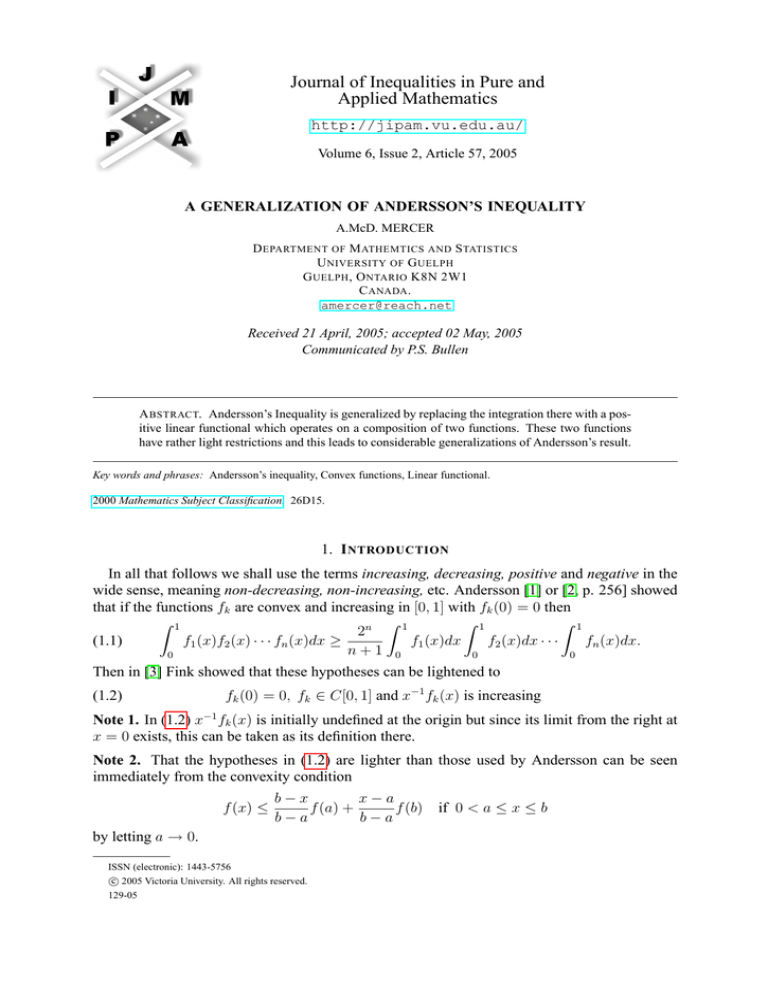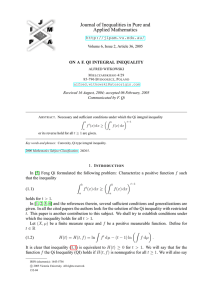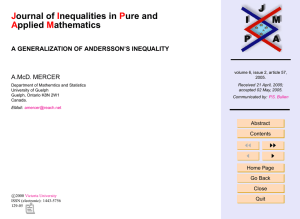
Journal of Inequalities in Pure and
Applied Mathematics
http://jipam.vu.edu.au/
Volume 6, Issue 2, Article 57, 2005
A GENERALIZATION OF ANDERSSON’S INEQUALITY
A.McD. MERCER
D EPARTMENT OF M ATHEMTICS AND S TATISTICS
U NIVERSITY OF G UELPH
G UELPH , O NTARIO K8N 2W1
C ANADA .
amercer@reach.net
Received 21 April, 2005; accepted 02 May, 2005
Communicated by P.S. Bullen
A BSTRACT. Andersson’s Inequality is generalized by replacing the integration there with a positive linear functional which operates on a composition of two functions. These two functions
have rather light restrictions and this leads to considerable generalizations of Andersson’s result.
Key words and phrases: Andersson’s inequality, Convex functions, Linear functional.
2000 Mathematics Subject Classification. 26D15.
1. I NTRODUCTION
In all that follows we shall use the terms increasing, decreasing, positive and negative in the
wide sense, meaning non-decreasing, non-increasing, etc. Andersson [1] or [2, p. 256] showed
that if the functions fk are convex and increasing in [0, 1] with fk (0) = 0 then
Z 1
Z 1
Z 1
Z 1
2n
(1.1)
f1 (x)f2 (x) · · · fn (x)dx ≥
f1 (x)dx
f2 (x)dx · · ·
fn (x)dx.
n+1 0
0
0
0
Then in [3] Fink showed that these hypotheses can be lightened to
(1.2)
fk (0) = 0, fk ∈ C[0, 1] and x−1 fk (x) is increasing
Note 1. In (1.2) x−1 fk (x) is initially undefined at the origin but since its limit from the right at
x = 0 exists, this can be taken as its definition there.
Note 2. That the hypotheses in (1.2) are lighter than those used by Andersson can be seen
immediately from the convexity condition
f (x) ≤
b−x
x−a
f (a) +
f (b) if 0 < a ≤ x ≤ b
b−a
b−a
by letting a → 0.
ISSN (electronic): 1443-5756
c 2005 Victoria University. All rights reserved.
129-05
2
A.M C D. M ERCER
An interesting special case of (1.1) is obtained by taking all the fk to be the same function f ,
when we get
Z 1
n
Z 1
2n
n
(1.3)
f (x)dx ≥
f (x)dx , n = 1, 2, . . .
n+1
0
0
and the obvious question arises here concerning the case of non-integral n.
It is the purpose of this paper to generalize Andersson’s result in a way that involves positive
linear functionals. With this aim in mind, in the next section we make some preparations and
then state our theorems.
2. D EFINITIONS AND S TATEMENT OF R ESULTS
Let the functions fk satisfy (1.2) and L denote a positive linear functional defined on C[0, 1].
We introduce a second set of functions φk defined by
φk = e1
L(fk )
,
L(e1 )
where e1 (x) = x.
Finally we let Fk denote functions defined and differentiable on the ranges of fk and φk . (If
only one of each of the functions above is involved in certain places we shall omit the subscript).
We now introduce our two theorems.
Theorem 2.1 will be a generalization of the special case (1.3) and Theorem 2.2 will be a
generalization of (1.1). We choose to proceed in this order since, on the one hand, Theorem
2.1 is of interest in its own right and, secondly, once it is proved, it is a simple matter to prove
Theorem 2.2.
Theorem 2.1. With f satisfying (1.2) and φ, F and L being as introduced above we have:
(a) If F 0 and g are increasing then
L[F (f )g] ≥ L[F (φ)g].
(2.1)
(b) If F 0 and g are decreasing then
L[F (f )g] ≤ L[F (φ)g].
Theorem 2.2. With fk satisfying (1.2) and φk , Fk and L being as introduced above we have
(a) If all the Fk and Fk0 are increasing then
" n
#
" n
#
Y
Y
L
Fk (fk ) ≥ L
Fk (φk )
k=1
k=1
and
(b) If all the Fk and Fk0 are decreasing then
" n
#
" n
#
Y
Y
Fk (fk ) ≤ L
Fk (φk )
L
k=1
k=1
Before proceeding we give an example of Theorem 2.1.
Example 2.1. In Theorem 2.1 take F (u) = uα , g(u) = 1 and let L be defined by
Z 1
L(w) =
w(t)dt.
0
Then
J. Inequal. Pure and Appl. Math., 6(2) Art. 57, 2005
http://jipam.vu.edu.au/
A G ENERALIZATION OF A NDERSSON ’ S I NEQUALITY
3
(a)
Z
(2.2)
0
1
2α
f (x)dx ≥
α+1
α
Z
α
1
f (x)dx
for − 1 < α ≤ 0 or α ≥ 1
0
and
(b)
Z
(2.3)
0
1
2α
f (x)dx ≤
α+1
α
Z
α
1
f (x)dx
for 0 ≤ α ≤ 1.
0
The values of α are determined by the behaviour of F 0 (except that the condition −1 < α is
required to ensure the convergence of the integral on the left).
The above example answers the question which arose at (1.3).
3. P ROOFS
First we need two lemmas.
Lemma 3.1. Let p, q ∈ C[0, 1], and L be a positive linear functional. Suppose that L(p) = 0
and that p(x) changes sign once, from negative to positive, in the interval and suppose that q(x)
is increasing there. Then
(a)
L(pq) ≥ 0
(b) If q(x) is decreasing then the inequality is to be reversed.
Proof of Lemma 3.1(a). If q(x) is constant the result is trivial. Otherwise there is γ ∈ (0, 1)
such that p(γ) = 0.
Then, defining
p1 (x) = min(0, p(x)) : p2 (x) = max(0, p(x)) in [0, 1]
we have
p1 (x)q(x) ≥ p1 (x)q(γ) in [0, γ)
and
p2 (x)q(x) ≥ p2 (x)q(γ) in [γ, 1]
So
L(pq) = L(p1 q) + L(p2 q)
≥ L(p1 q(γ)) + L(p2 q(γ))
= q(γ)L(p) = 0
which completes the proof of (a). The proof of Lemma 3.1(b) is similar.
The next lemma was proved in [3] for the case in which L is integration over [0, 1]. Here we
give a different proof which refers to a general positive linear functional.
Lemma 3.2. With f and φ as above we have
(a)
L(f )
g ≥ 0 for all f
L[(f − φ)g] ≡ L f − e1
L(e1 )
if g is increasing. (If g is constant or if f = φ we will have equality)
(b) The inequality is to be reversed if g is decreasing.
J. Inequal. Pure and Appl. Math., 6(2) Art. 57, 2005
http://jipam.vu.edu.au/
4
A.M C D. M ERCER
Proof of Lemma 3.2(a). First we observe that the difference
f (x) − φ(x) ≡ f (x) − x
L(f )
L(e1 )
changes sign in (0, 1) because x−1 f (x) is increasing and both
f (x) − x
L(f )
> 0 and
L(e1 )
f (x) − x
L(f )
< 0 in 0 ≤ x ≤ 1
L(e1 )
are seen to be impossible, on operating through with L. Clearly, this sign change is from minus
to plus.
It is also clear that
L(f − φ) = 0
and so the result follows on taking
f − φ = p and g = q
in Lemma 3.1(a). The proof of part (b) is similar.
Proof of Theorem 2.1(a). F 0 and g are increasing functions. Then
(3.1)
[F (f (x)) − F (φ(x))]g(x) = [f (x) − φ(x)]Q(x)g(x),
where
Z f (x)
1
Q(x) ≡
F 0 (t)dt
[f (x) − φ(x)] φ(x)
It is a simple matter to see that this quotient is increasing with x.
In fact, it is obvious since Q(x) is the average value of the increasing function F 0 over the
interval (f (x), φ(x)) [or (φ(x), f (x))], each of whose end-points moves to the right with increasing x.
Since Qg is an increasing function, then from (3.1) we get
L[F (f )g − F (φ)g] = L[(f − φ)Qg] ≥ 0
on applying Lemma 3.2 to the right hand side.
This concludes the proof of Theorem 2.1(a) and the proof of part (b) is similar.
Note 3. The function g played no significant part in this proof but its presence is needed when
we come to deduce Theorem 2.2 from Theorem 2.1.
Proof of Theorem 2.2(a). For the sake of brevity we shall take n = 3 because this will indicate
the method of proof for any n > 1.
We have
L[F1 (f1 )F2 (f2 )F3 (f3 )] ≥ L[F1 (f1 )F2 (f2 )F3 (φ3 )]
on reading F1 (f1 )F2 (f2 ) as g in (2.1).
Then
L[F1 (f1 )F2 (f2 )F3 (φ3 )] ≥ L[F1 (f1 )F2 (φ2 )F3 (φ3 )]
on reading F1 (f1 )F3 (φ3 ) as g in (2.1).
Finally
L[F1 (f1 )F2 (φ2 )F3 (φ3 )] ≥ L[F1 (φ1 )F2 (φ2 )F3 (φ3 )]
on reading F2 (φ2 )F3 (φ3 ) as g in (2.1).
The general case is proved in exactly the same way. This concludes the proof of Theorem
2.2(a) and that of part (b) is similar.
J. Inequal. Pure and Appl. Math., 6(2) Art. 57, 2005
http://jipam.vu.edu.au/
A G ENERALIZATION OF A NDERSSON ’ S I NEQUALITY
5
R EFERENCES
[1] B.X. ANDERSSON, An inequality for convex functions, Nordisk Mat. Tidsk, 6 (1958), 25–26.
[2] D.S. MITRINOVIĆ, J.E PEČARIĆ
Kluwer, 1993.
AND
A.M. FINK, Classical and New Inequalities in Analysis,
[3] A.M. FINK, Andersson’s Inequality, Math. Inequal. & Applics, 6(3) (2003), 241–245.
J. Inequal. Pure and Appl. Math., 6(2) Art. 57, 2005
http://jipam.vu.edu.au/








